#quickbase
Explore tagged Tumblr posts
Text

Join Now:https://meet.goto.com/121079021
Attend New Online Demo On Unqork (No-Code) by Mr. Sai.
Demo on: 8th December 2023 @ 7:30 AM (IST).
Contact us: +91 9989971070.
Join us on Telegram: https://t.me/+bEu9LVFFlh5iOTA9
Join us on WhatsApp: https://www.whatsapp.com/catalog/919989971070Visit: https://www.visualpath.in/Unqork-online-training.html
#unqork#nocodeplatform#applicationdevelopment#digitaltransformation#enterprisesolutions#workflowautomation#PegaPlatform#Servicenow#quickbase#PowerApps#Salesforce#mendixplatform#FreeDemo#onlinetraining#Visualpath#education#newtechnology#SoftwareCourses
0 notes
Text
Get started with QBasic ...

Contents At A Glance
Introduction to QBasic
Using The QBasic Environment
Working With Data
Operators And String Variables
Advanced Input And Output
Making Decisions With Data
Controlling Program Flow
Data Structures
Buit-In Functions
Programming Subroutines
Disk Files
Sound And Graphics
Debugging Your Programs

Post #344: Greg Perry & Steven Potts, Crash Course in QBasic, The Fastest Way To Move To QBasic, Second Edition, QUE Corporation, Indianapolis, USA, 1994.
#programming#retro programming#vintage programming#basic#basic programming#education#qbasic#quickbasic#qbasic programming#microsoft#que corporation#i love qbasic#i love quickbasic#dos programming
18 notes
·
View notes
Text
i always interpreted "LPRINT" as "literally print"
4 notes
·
View notes
Text
DOS Compilers (GitHub repo) https://github.com/davidly/dos_compilers
0 notes
Text
So I just got a large haul of computer stuff I’m super excited to show off!! I’ll detail some things in its their posts, but here’s an overview of what I got:
Three computer towers:
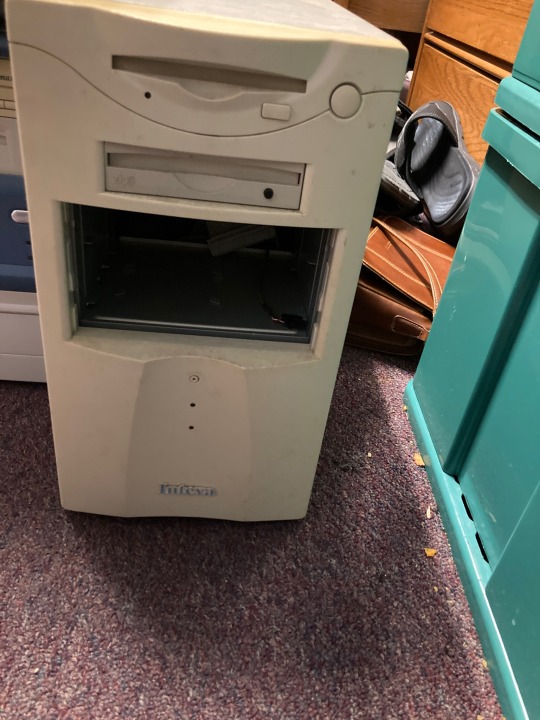
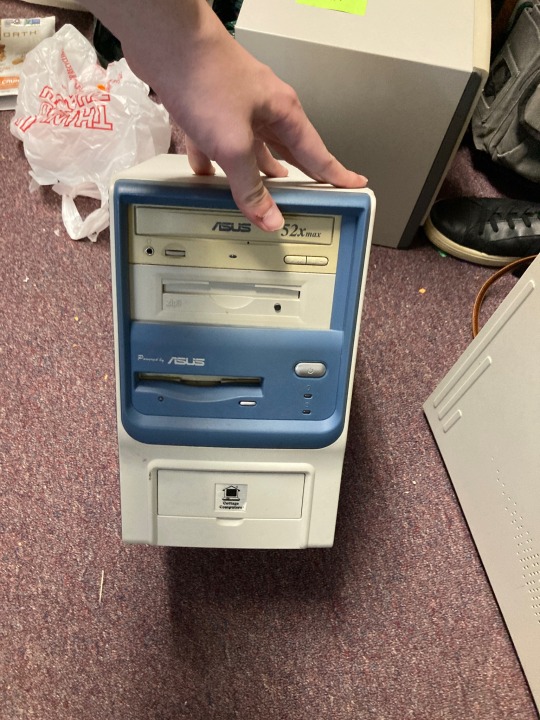
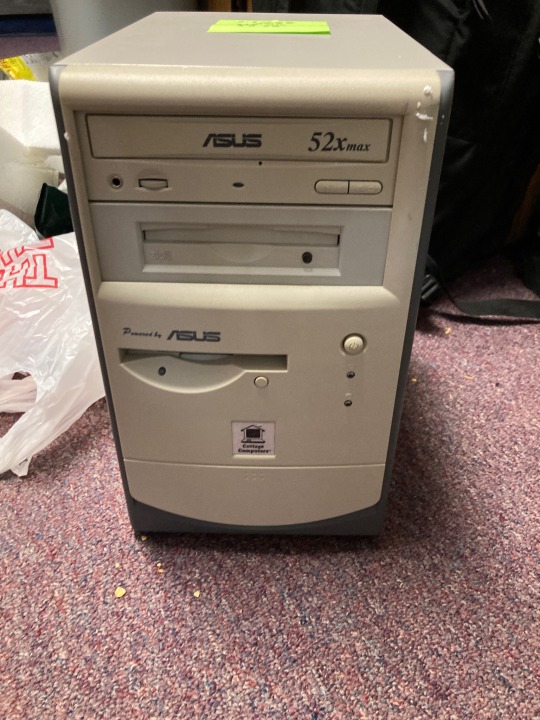
Some assorted peripherals and accessories:
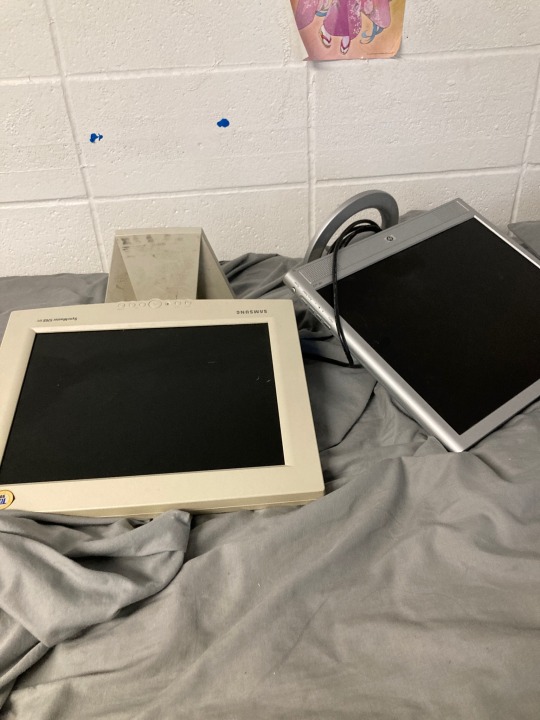
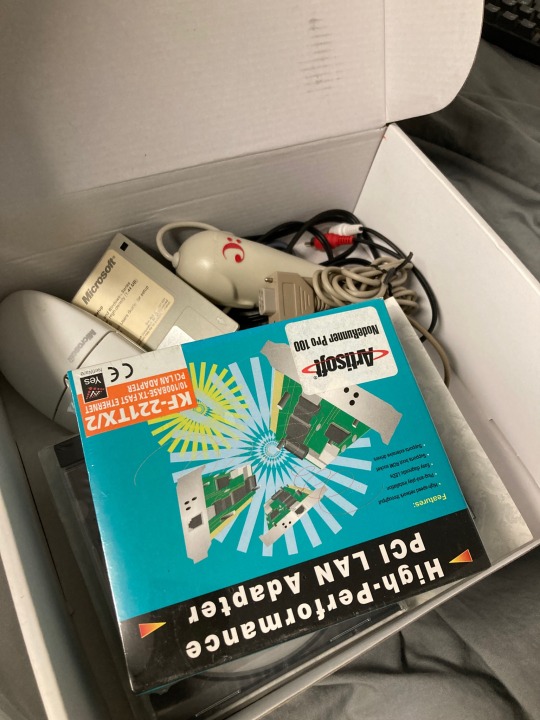
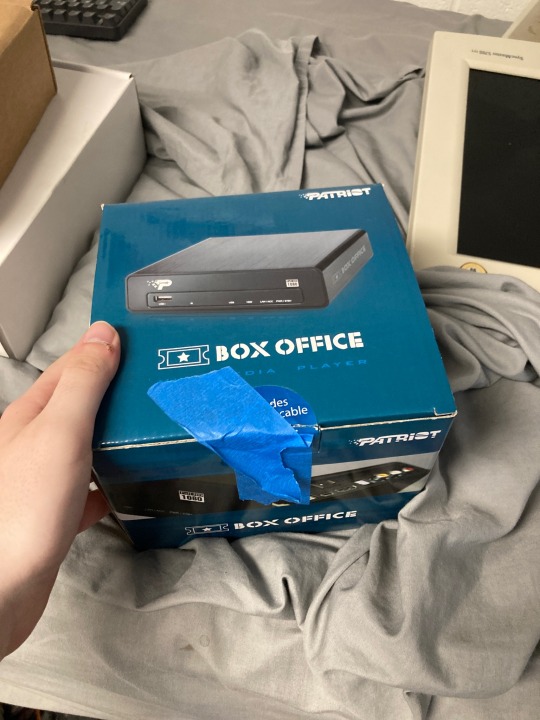

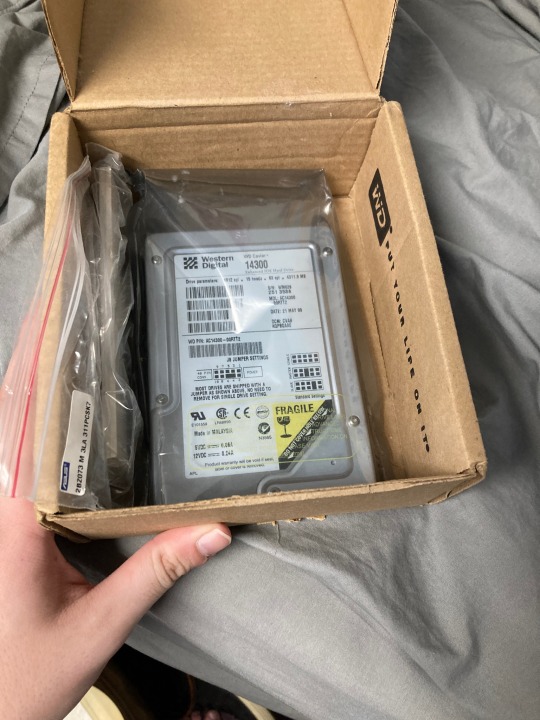
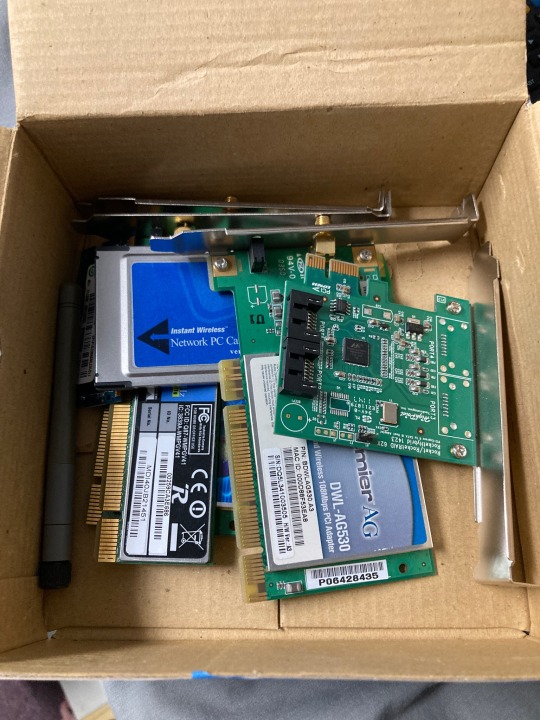
And two boxes full of software, including sealed QuickBASIC on low density 5.25” diskettes!!
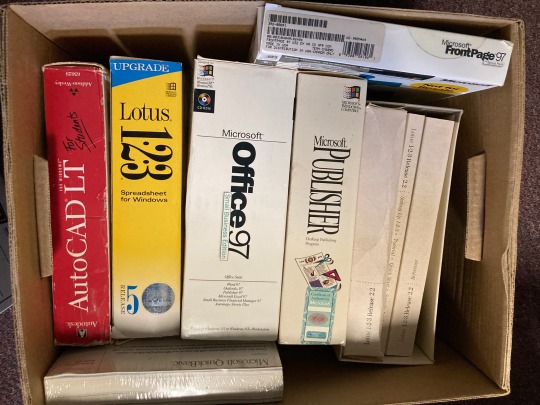
I’m so absolutely excited to do more with this stuff!!!
108 notes
·
View notes
Text
Say, for the sake of argument, you want to make a bad programming language. Why would you do this?
Well, for instance, you might get your hands on a book of scripts to generate ephemera for celestial events, only to find out it was written for Microsoft QuickBasic for Macintosh System 7. You quickly discover that this particular flavor of BASIC has no modern interpreter, and the best you can do is an emulator for System 7 where you have to mount 8 virtual floppy disks into your virtual system.
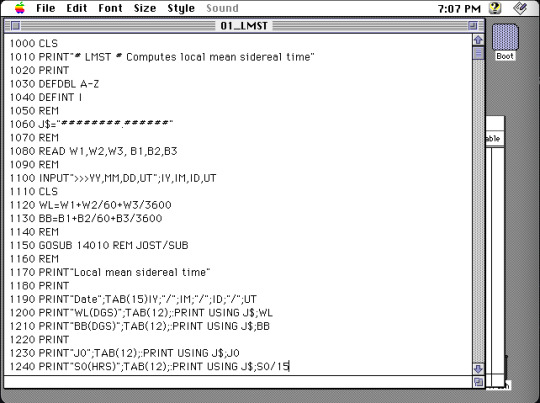
You could simply port all the scripts to another BASIC, but at that point you might as well just port them to another langauge entirely, a modern language.
Except QuickBasic had some funky data types. And the scripts assume a 16-bit integer, taking advantage of the foibles of bitfutzery before converting numbers into decimal format. BASIC is very particular -- as many old languages are -- about whitespace.
In addition to all this, BASIC programs are not structured as modern programs. It's structured to be written in ed, one line at a time, typing in a numbered index followed by the command. There are no scopes. There are no lifetimes. It's just a loose collection of lines that are hopefully in a logical order.
So sure, I could port all these programs. But I'm sure to make mistakes.
Wouldn't it just be easier, some basal part of my brain says, to write your own language that some some modern ameneties, that you compile for your own laptop, that kind of acts like BASIC? A language where you just have to translate particular grammar, and not the whole structure of the program?
Of course it's not easier. But I'm already too far in to quit now.
Memory
Who doesn't love manual memory layout?
In QuickBasic, memory is "kind of" manual. The DEFINT and DEFDBL keywords let you magically instantiate types based on their first letter. I don't know how you deallocate things, because all the scripts in this book finish quickly and don't hang around to leak a lot.
In QuickBasic, this looks like
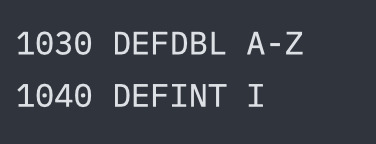
I guess that the second statement just overrides the first.
There is no stack in a BASIC program, so there will be no stack in my language. Instead you just give names to locations.

creates a symbol named age and makes it refer to 0x1F. The pointer operator should be obvious, and the walrus means we're defining a symbol (to be replaced like a macro), not doing a value assignment during the execution of the program. Now we can assign a value.
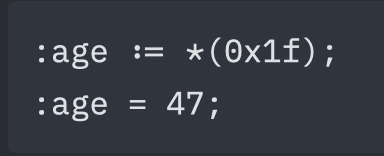
Atoms infer types. age knows it's an int.
You cannot assign a new type to an atom.
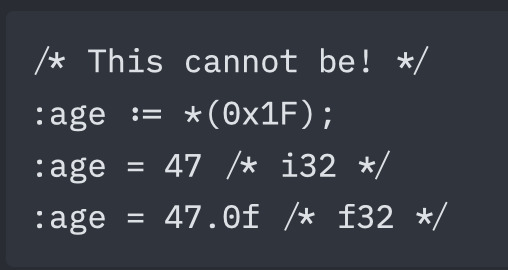
However, you can cast between types by creating two atoms at the same address, typed differently.
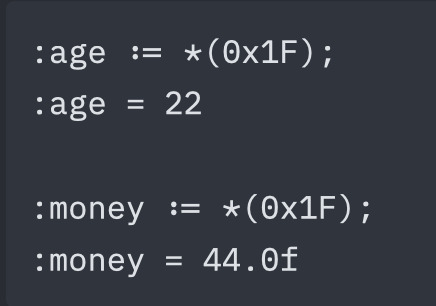
The language does not convert these, it simply interprets the bits as the type demands.
Larger types
Not all types are a single word. Therefore, you can use the range operator .. to refer to a range of addresses.

Note that strings are stored with an extra byte for its length, instead of null-terminating it. Assignment of a string that is too long will result in a compilation error.
Next and Auto
There are also two keywords to make the layout of memory easier. The first is :next which will place the span in the next available contiguous location that is large enough to hold the size required. The second is :auto. For all :auto instances, the compiler will collect all these and attempt to place them in an intelligent free location. :auto prefers to align large structs with 64-word blocks, and fills in smaller blocks near other variables that are used in the same code blocks.
String Allocation
Strings come with a macro to help automatically build out the space required:

This is equivalent to:

That is, a string with capacity 5, a current size of 0, and zeroes (null char) in all spots. This helps avoid memory reuse attacks. ZBASIC is not a secure language, but this is still good practice.
There is also another macro that is similar to a "string literal".

Verbose and annoying! Just like BASIC.
Array Allocation
Likewise, arrays have a similar macro:

Which expands in a similar way as strings, with a capacity word and size word. The difference here is that the type given may change the actual size of the allocation. Giving a type that is larger than a single word will result in a larger array. For instance, f64 takes up two words some systems, so array::empty!(5, f64) will allocate 10 words in that case (5 * 2). Larger structs will likewise take up even more space. Again, all this memory will be zeroed out.
Allocation order
As an overview, this is the order that memory is assigned during compilation:
Manual Locations -> Next -> Auto
Manual locations are disqualified from eligibility for the Next and Auto phases, so a manual location will never accidentally reference any data allocated through :next or :auto.
Here is an example:
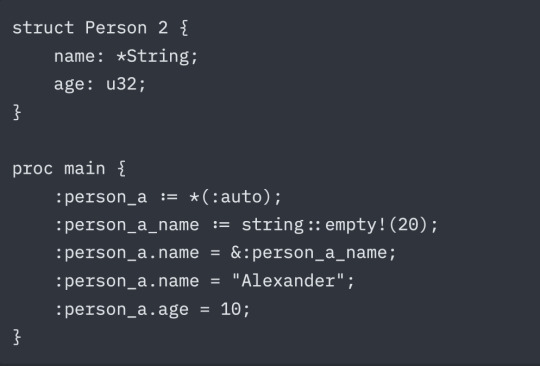
This produces the initial layout:

Which, after the code is run, results in the memory values:

Note that types are not preserved at runtime. They are displayed in the table as they are for convenience. When you use commands like "print" that operate differently on different types, they will be replaced with one of several instructions that interpret that memory as the type it was at compile-time.
Truly awful, isn't it?
3 notes
·
View notes
Text
MarioUp (DOS, Gilberto Lima Correia/MasterSoft, ~1999/2000)
You can play this Brazilian fangame made in QuickBasic here.
Controls: arrows and Ctrl.

#internet archive#in-browser#dos#dos games#game#games#video game#video games#videogame#videogames#computer game#computer games#obscure games#fangame#fangames#fan game#fan games#brazil#brazilian#1999#2000#1990s#90s#2000s
10 notes
·
View notes
Text
Czarina-VM, study of Microsoft tech stack history. Preview 1

Write down study notes about the evolution of MS-DOS, QuickBASIC (from IBM Cassette BASIC to the last officially Microsoft QBasic or some early Visual Basic), "Batch" Command-Prompt, PowerShell, Windows editions pathing from "2.11 for 386" to Windows "ME" (upgraded from a "98 SE" build though) with Windows "3.11 for Workgroups" and the other 9X ones in-between, Xenix, Microsoft Bob with Great Greetings expansion, a personalized mockup Win8 TUI animated flex box panel board and other historical (or relatively historical, with a few ground-realism & critical takes along the way) Microsoft matters here and a couple development demos + big tech opinions about Microsoft too along that studious pathway.
( Also, don't forget to link down the interactive-use sessions with 86box, DOSbox X & VirtualBox/VMware as video when it is indeed ready )
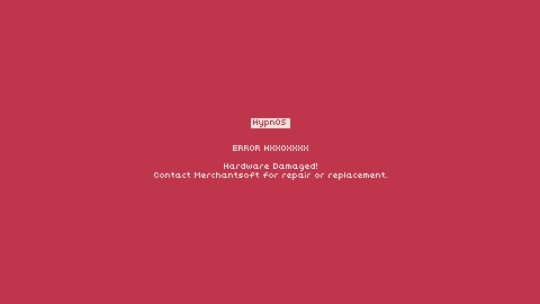
Yay for the four large tags below, and farewell.
#youtube#technology#retro computing#maskutchew#microsoft#big tech#providing constructive criticisms of both old and new Microsoft products and offering decent ethical developer consumer solutions#MVP deliveries spyware data privacy unethical policies and bad management really strikes the whole market down from all potential LTS gains#chatGPT buyout with Bing CoPilot integrations + Windows 8 Metro dashboard crashes being more examples of corporate failings#16-bit WineVDM & 32-bit Win32s community efforts showing the working class developers do better quality maintenance than current MS does
5 notes
·
View notes
Text
Low Code Development Platform Market Size, Share, Analysis, Forecast, and Growth Trends to 2032: Transforming Software Development for SMEs and Enterprises
The Low Code Development Platform Market size was recorded at USD 22.80 Billion in 2023 and is expected to surpass USD 271.7 Billion by 2032, growing at a CAGR of 31.7% over the forecast period of 2024-2032.
Low Code Development Platform Market is rapidly transforming the software development landscape by enabling faster application creation with minimal coding. Businesses across industries are adopting these platforms to empower non-technical users, accelerate digital transformation, and cut down development costs. With strong traction in the USA and growing adoption across Europe, the market is reshaping how organizations approach innovation.
US Low Code Development Platform Market Set for Rapid Growth
Low Code Development Platform Market is gaining momentum as demand for agility and speed in application delivery increases. Enterprises are leveraging low code tools to bridge the IT-business gap, streamline workflows, and respond faster to changing customer and market needs without relying solely on traditional development teams.
Get Sample Copy of This Report: https://www.snsinsider.com/sample-request/2877
Market Keyplayers:
Appian
LANSA
Pegasystems Inc.
AgilePoint
Oracle
Betty Blocks
Mendix Technology BV
Microsoft
OutSystems
Salesforce, Inc.
ServiceNow
Zoho Corporation Pvt. Ltd.
Quickbase
Creatio
Market Analysis
The Low Code Development Platform Market is being driven by the need for faster digital solutions, a shortage of skilled developers, and increasing pressure to deliver personalized user experiences. These platforms enable organizations to create robust, scalable apps without deep coding knowledge, supporting rapid innovation. The USA leads the adoption wave, fueled by tech-forward enterprises and startup ecosystems. Meanwhile, Europe's regulatory environment encourages secure, compliant, and citizen developer-friendly solutions.
Market Trends
Rise of citizen development enabling non-IT staff to build apps
Integration of AI and ML tools for intelligent automation
Adoption in large enterprises for complex app development
Growing popularity of drag-and-drop interfaces
Expansion of platforms with cloud-native architecture
Enhanced support for enterprise-level security and governance
Vertical-specific low code solutions in healthcare, finance, and logistics
Market Scope
Low code platforms are redefining digital agility across sectors. They offer the capability to launch MVPs quickly, integrate with legacy systems, and adapt to evolving user needs with minimal resource investment.
Democratization of app development
Seamless third-party and API integrations
Cross-platform functionality (web, mobile, desktop)
Workflow automation and digital forms
Reduced time-to-market for new applications
Lower development and maintenance costs
Empowerment of hybrid teams (IT + business units)
Forecast Outlook
The Low Code Development Platform Market is expected to experience dynamic growth, propelled by business demand for rapid innovation and operational flexibility. As more enterprises embrace hybrid work and digital-first strategies, low code platforms will become foundational to agile app development. Key to market leadership will be scalability, customization capabilities, and support for governance, making these platforms essential for enterprise-grade digital ecosystems in both mature and emerging markets.
Access Complete Report: https://www.snsinsider.com/reports/low-code-development-platform-market-2877
Conclusion
The Low Code Development Platform Market is no longer a tech trend—it’s a core enabler of modern business agility. Whether it's a startup in Berlin or a Fortune 500 in New York, companies are embracing low code to move faster, innovate smarter, and close the developer gap.
Related Reports:
Explore the growth of the digital twin market in the US
Analyze growth opportunities in the US DataOps platforms industry
About Us:
SNS Insider is one of the leading market research and consulting agencies that dominates the market research industry globally. Our company's aim is to give clients the knowledge they require in order to function in changing circumstances. In order to give you current, accurate market data, consumer insights, and opinions so that you can make decisions with confidence, we employ a variety of techniques, including surveys, video talks, and focus groups around the world.
Contact Us:
Jagney Dave - Vice President of Client Engagement
Phone: +1-315 636 4242 (US) | +44- 20 3290 5010 (UK)
#Low Code Development Platform Market#Low Code Development Platform Market Size#Low Code Development Platform Market Share#Low Code Development Platform Market Scope#Low Code Development Platform Market Growth#Low Code Development Platform Market Trends
0 notes
Text
QuickBasic für Linux - QB64 unter Debian Linux Bookworm installieren
0 notes
Text

Post #321: Racunari, Computer Magazine, 1980 - 1990, 2024.
#programming#basic#vintage programming#retro programming#education#basic programming#iloveprogramming#ilovebasic#ilovegwbasic#gwbasic#quickbasic#racunari
4 notes
·
View notes
Text
so like. what happened to QB64. where did the good, professional looking wiki go? the one that calls you a caveman for using "let"?
4 notes
·
View notes
Text
Decoding the Future: An In-Depth Look at the Global No-Code AI Platform Market
Global No-Code AI Platform Market size reached USD 4447.0 million in 2023, with projections indicating that the industry revenue is likely to be USD 5625.4 million by the end of 2024. The no-code AI platform industry is anticipated to be valued at USD 31155.5 million by 2031, exhibiting a compound annual growth rate (CAGR) of 27.70% between 2024 and 2031.
This comprehensive research study on the global No-Code AI Platform market offers detailed analyses of market trends, prominent drivers, and future growth prospects, providing readers with an extensive understanding of the market environment necessary for informed business decisions. Covering various aspects such as estimated market sizing, strategies employed by leading companies, restraining factors, and challenges faced by market participants, the report equips stakeholders with actionable insights.
Get a New Look of Sample PDF: https://www.kingsresearch.com/request-sample/no-code-ai-platform-market-739
Market Forecast and Trends
Precise market forecasts and identification of emerging trends enable stakeholders to anticipate the industry’s future trajectory and develop strategic tactics accordingly, providing a competitive edge in a dynamic business landscape.
Regional and Segment Analysis
The study facilitates industry participants in identifying high-growth regions and profitable market segments through region-specific and segment-by-segment analysis. This information aids in devising effective marketing strategies and product lineups tailored to the preferences and needs of diverse target audiences across major regions including North America, Europe, Asia Pacific, Latin America, and the Middle East & Africa.
Investment and Expansion Opportunities
The research report unveils prospective areas for investment and business growth in the global No-Code AI Platform market, enabling strategic decision-making for readers seeking to expand into new markets or introduce new products.
Competitive Analysis
In-depth competitive analysis profiles major market competitors and evaluates their strategies, weaknesses, and market shares. Insights into top business strategies employed by key players such as partnerships, alliances, mergers, acquisitions, product innovations, and development empower industry participants to benchmark their businesses against rivals and devise winning strategies for market differentiation.
The major players in the No-Code AI Platform Market are:
Akkio Inc.
Amazon Web Services, Inc.
Apple Inc.
Caspio, Inc.
Clarifai, Inc.
DataRobot, Inc.
Google
Microsoft
Quickbase
Shnoco
Reasons to Purchase This Report:
Futureproof Decisions: Gain precise market forecasts and identify emerging trends to confidently navigate the future of the No-Code AI Platform market.
Competitive Advantage: Outperform rivals with a comprehensive competitive analysis, revealing their strategies and market share.
Growth Catalysts Exposed: Uncover the key factors driving market expansion and leverage them to propel your business forward.
Profitable Opportunities: Pinpoint high-growth regions and lucrative market segments through in-depth regional and segment analysis.
Investment Guidance: Strategically plan investments and expansions in the global No-Code AI Platform market with insights on potential growth areas.
Informed Decisions: Utilize precise market forecasts and in-depth analysis to make data-driven business decisions.
Market Expertise: Deepen your understanding of market trends and growth drivers for a comprehensive market landscape overview.
Actionable Insights: Gain practical takeaways from the report's competitive analysis, market sizing, and future projections.
The Global No-Code AI Platform Market is Segmented as:
By Component
No-Code AI Platform Tool
Services
By Deployment
Cloud
On-Premises
By Technology
Natural Language Processing (NLP)
Computer Vision
Predictive Analytics
By Region
North America
U.S.
Canada
Mexico
Europe
France
U.K.
Spain
Germany
Italy
Russia
Rest of Europe
Asia-Pacific
China
Japan
India
South Korea
Rest of Asia-Pacific
Middle East & Africa
GCC
North Africa
South Africa
Rest of Middle East & Africa
Latin America
Brazil
Argentina
Rest of Latin America
0 notes
Text

Quickbase Adds to Executive Team with Two New Appointments, Strengthening Ability to Deliver Dynamic Work Management Solutions http://dlvr.it/T8Xc54
0 notes